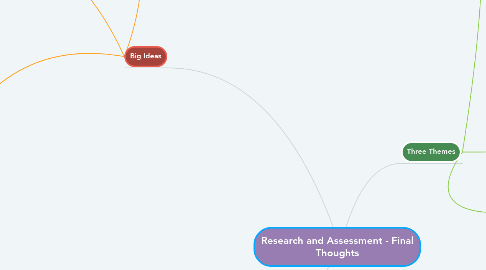Research and Assessment - Final Thoughts
by Brian Tan

1. Big Ideas
2. Actions
3. When evaluating, it is important to intentionally select the types of evidence that you are going to judge. It is up to the teacher to use their professional judgement to interpret if the learning goals and standards have been met and decide on a method to give value to student’s learning. There are different ways to set up a markbook, such as by: - Unit - KICA - Type of assignment - Curriculum expectation The most important aspect at the end of this process is to make sure to give feedback to students about their learning, using the 7 tenets listed in my actions
4. Triangulation of assessment – there are many ways that teachers are already collecting evidence (research!) of student learning. This includes: Conversational evidence Observational evidence Written evidence Peer assessment and self-assessment are good indicators of student learning as well and should be taken into account.
5. Bento Box – Teachers should have a variety of assessment strategies that they can employ in the classroom to assess students in different ways.
6. I plan on using different assessment strategies from my bento box, including: Infographic Reading technique for non-fiction – great for understanding readings at the senior high school level RAFT (Role, Audience, Topic, Format) Four corners Two roses and a thorn
7. I plan to implement the action research cycle to see how effective my teaching and assessment methods are. This will help me be more creative and reflective in my teaching practice.
8. One action I will modify is that I will stop referring to global citizenship as if it is the same as the global competencies. The global competencies are a skillset to help 21st century learners succeed in the real word, whereas global citizenship is the responsibility that everyone has as being part of the world, regardless of cultural or social differences.
9. Three Themes
10. Messages In, Messages Out Effective comments focus on and refer to: - Specific aspects of knowledge, skills, and other criteria identified in the curriculum, or on the learning skills and work habits, that are most relevant to the student’s achievement or development in the reporting period - Significant strengths that the student has demonstrated and should try to continue to demonstrate - Key next steps for improvement that address the student’s most significant learning needs - Provide concrete next steps for the student - Provide specific suggestions for how parents can support the student’s learning or the development of learning skills and work habits – Reporting Student Learning, 2010, p. 6.
11. Connecting High and Low Action Research Cycle: Plan, Act, Observe, Reflect One way that we can incorporate research into our daily practice is to use the action research cycle and re-visit it on PD days with your department. The first step is to plan what sort of action you want to take. In my last practicum, we wanted to use critical thinking questioning techniques to improve student engagement. On a PD day, we created reflection questions that students could use after a performance test within music, drama, or dance. After student’s first performance test, we gave them the reflection to fill out. We observed that the questions were good critical thinking questions in the fact that it made students write more detail and think differently about their perceptions of their performance and working with others. We recognized the critical thinking questions were useful but could be improved on to allow students to apply their skill of critical thinking and reflection to topics other than music, drama, or dance performance.
12. Research and Assessment as Human Activities The Seven Fundamental Principles To ensure that assessment, evaluation, and reporting are valid and reliable, and that they lead to the improvement of learning for all students, teachers use practices and procedures that: • are fair, transparent, and equitable for all students; • support all students, including those with special education needs, those who are learning the language of instruction (English or French), and those who are First Nation, Métis, or Inuit; • are carefully planned to relate to the curriculum expectations and learning goals and, as much as possible, to the interests, learning styles and preferences, needs, and experiences of all students; • are communicated clearly to students and parents at the beginning of the school year or course and at other appropriate points throughout the school year or course; • are ongoing, varied in nature, and administered over a period of time to provide multiple opportunities for students to demonstrate the full range of their learning; • provide ongoing descriptive feedback that is clear, specific, meaningful, and timely to support improved learning and achievement; • develop students’ self-assessment skills to enable them to assess their own learning, set specific goals, and plan next steps for their learning." - Growing Success, 2010, p. 6
13. When giving feedback to students verbally or written, I will ensure that the feedback is: - Goal-referenced - Tangible and transparent - Actionable - User-friendly (appropriate to the level that a student is working at) - Timely - Ongoing -Consistent


